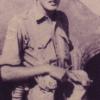In the spring of 1944 I was serving with 575 Sqn at RAF Broadwell (equipped with C-47 Dakotas) and I remember that on one practice jump over the UK prior to D-Day, one paratrooper became caught up behind the aircraft after he jumped out, as his static line refused to part from his parachute pack. To make matters worse the parachute came out of the pack but instead of deploying properly and pulling the man free, it wound round and round in the slip stream behind him in typical Roman candle fashion. No amount of pulling on the static line from inside the aircraft by the dispatches could get this man to the door, so the decision was made to fly to Poole harbour, alert the Royal Navy and with flaps down to fly really slow and low and have the static line cut. This they did but to avoid a stall, the man still had to be released at 80 to 90 mph and despite their best efforts the paratrooper died shortly after he was recovered from the water. I later learned that the Para was in fact Lt John Alexander Daniel Williams of the 83rd Field Regt. Royal Artillery and the incident occurred on 18th March 1944.
As a consequence of this accident I was tasked with a few others on the Squadron to come up with a way of recovering such 'hang ups' in flight and to do so we had a full size dummy made of the correct weight for a typical soldier (and not to be confused with those Para dummies, of the sort dropped into Normandy to confuse the Germans). Test flights were then carried out with the dummy wearing a parachute pack which was then thrown out with a fixed static line. At first it was thought that just a long barge pole might do the trick in that the Dispatchers could hook in the man but the slip stream was too great and so another method was thought up. This involved fitting a clamp to the static line and placing it as far down it as the crew could reach. This clamp could be put in place and tightened quickly. On the clamp was a shackle which attached to a steel cable which in turn was connected to a winch attached to the bulkhead behind the cockpit. Winching was done by hand rather than an electric winch as far as I can remember but nevertheless it had the desired effect, and with the clamp in place it was possible for us to retrieve our ‘man’ and pull him back to the door for others with poles to assist in hauling him aboard. I transferred from 575 Sqn at Broadwell to 48 Sqn at Down Ampney in April 1944 so these trials occurred during March or April 1944.
Despite its success I have never heard of this mechanism or method ever being fitted as standard to any Allied aircraft. So I’m told British Paras never wore a reserve chute at this time, and because airborne hang ups were rare, perhaps men were just cut 'free' if it ever happened and were counted as just another loss! Presumably the introduction of reserve chutes also helped, assuming the Para could jettison his existing parachute, if it was caught by its static line.
The Late Sqn Leader Frank Hayward (ex LAC in 1944)
By Rebecca Blackburn
Source: Courtesy of Larry Hayward
Read More




Latest Comments
There are currently no comments for this content.
Add Comment
In order to add comments you must be registered with ParaData.
If you are currently a ParaData member please login.
If you are not currently a ParaData member but wish to get involved please register.